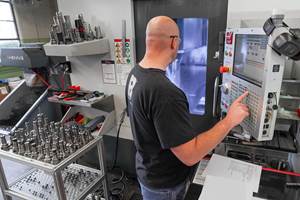Manual Pallet Changers Bring Agility To The Shop
Continually searching for ways to reduce workpiece cost and to improve its responsiveness to customer demands, V-Line recently discovered how a manually operated pallet changing system could make a significant contribution to meeting its continuous improvement goals.
Share








V-Line Precision Products of Walled Lake, Michigan, a suburb of Detroit, is a small job shop that employs 40 people during two shifts each day. The company is in the final stages of obtaining its ISO certification, so it employs quality control methods that are approved and that meet stringent military specifications. The company also designs and builds tooling for most of its jobs in its in-house toolroom.
Continually searching for ways to reduce workpiece cost and to improve its responsiveness to customer demands, V-Line recently discovered how a manually operated pallet changing system could make a significant contribution to meeting its continuous improvement goals. The company recently applied Setup-Switcher units from SMW Systems, Inc. (Santa Fe Springs, California) to two of its vertical machining centers. The units consist of a power-operated pallet locating and clamping fixture that is mounted on the machine table, two precision cast iron pallets that are switched on and off the fixture by sidewise indexing shuttle tables, extra pallets that are stored on shelves and an adjustable-height cart that is used to transport extra pallets between the shelves and machines. The pallets are cast iron, and both pallets and clamp fixture are fitted with hardened and ground precision locators, bushings and rest surfaces. The pallets are guaranteed to repeat within 0.0002 inch.
Fred Verbridge, V-Line’s president, explains how the systems have contributed to the company’s success. “We machine a wide variety of workpieces in lot sizes that range from 1 to 1,000. Our average run is 20 pieces. On the shorter runs we changeover two to three times per shift. On these runs the pallet changers drastically reduce setup downtime because setups are made on an off-line pallet, not on the machine table, so the machine is cutting parts while the new setup is being made. Off-line setup saves us about 35 minutes. Changeovers that used to take 45 minutes now take 10 minutes. Multiply 35 minutes by four to six changeovers per day, and it adds up fast.
“On longer runs the savings derive from cleaning chips and unloading and loading parts on the off-line pallet instead of the machine table. The machine cuts parts while these tasks take place. The only downtime we have is the 1 minute required to switch the completed part and fresh part pallets. Besides making money for us at both ends of the lot-size spectrum, the Setup-Switchers have also made us more responsive to emergency and ‘overnight’ orders.”
Mr. Verbridge says that the company purchased extra pallets so it could mount repeat order pre-aligned fixtures on them and store them on shelves. “When a rush order comes in, we can have it under the spindle in less than 30 minutes. On short runs we can deliver in 24 hours, and our customers love us.”
Another advantage pallet changers offer is the ability to nearly eliminate downtime while inspecting the first part of a new run. Once the new job is set up on a pallet away from the machine, it is transported to the machine. The current job being run is interrupted, and its pallet is switched with the new one. Next, machining programs are switched and the first new part is machined. The pallets and programs are then switched back, so machining continues while the new part is being inspected. Many shops inspect the new part while it is still on the pallet, which saves inspection time.
Similar to most shops, V-Line has found it difficult to find and hire skilled machinists. However, with advantages gained by employing pallet changers, the company is able to run its entire second shift with only one skilled setup person. It discovered that these accessories can often double machine output; double the output of the skilled personnel involved; and save the costs associated with a second machine, an operator, tooling and floor space. The impact these economies have on a company’s bottom line is the force behind the growing popularity of pallet changers in shops that will continue to “survive the cut.”
Related Content
Medical Shop Performs Lights-Out Production in Five-Axes
Moving to five-axis machining enabled this shop to dramatically reduce setup time and increase lights-out capacity, but success relied on the right combination of workholding and automation.
Read MoreRail Manufacturer Moves Full Steam Ahead with Safe, Efficient Workholding Solution
All World Machinery Supply paired a hydraulic power unit with remote operating capabilities in a custom workholding system for Ahaus Tool & Engineering.
Read MoreWorkholding Fixtures Save Over 4,500 Hours of Labor Annually
All World Machinery Supply designs each fixture to minimize the number of operations, resulting in reduced handling and idle spindle time.
Read MoreParts and Programs: Setup for Success
Tips for program and work setups that can simplify adjustments and troubleshooting.
Read MoreRead Next
5 Rules of Thumb for Buying CNC Machine Tools
Use these tips to carefully plan your machine tool purchases and to avoid regretting your decision later.
Read MoreSetting Up the Building Blocks for a Digital Factory
Woodward Inc. spent over a year developing an API to connect machines to its digital factory. Caron Engineering’s MiConnect has cut most of this process while also granting the shop greater access to machine information.
Read MoreRegistration Now Open for the Precision Machining Technology Show (PMTS) 2025
The precision machining industry’s premier event returns to Cleveland, OH, April 1-3.
Read More





















.png;maxWidth=150)

















.jpg;maxWidth=300;quality=90)










